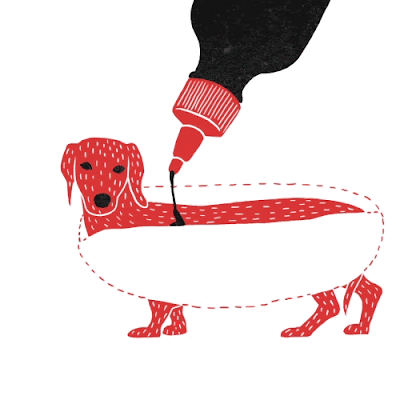New NPR 探索馬諦斯
The Bathers
By Herni Matisse
下載聲音檔請點我
FROM NPR
At MoMA, A Look At A Pivotal Moment For Matisse
French artist Henri Matisse 馬諦斯is probably best-known for最為人所熟知的his decorative裝飾性 and colorful paintings, especially nudes裸女 and still lifes靜物畫. But a current show at the Museum of Modern Art called "Matisse: Radical Invention," focuses on a period in his life from 1913 to 1917, when he was experimenting with different styles.
Our critic Lloyd Schwartz has a review.
LLOYD SCHWARTZ: In 2003, the Museum of Modern Art紐約現代美術館 put on an important show comparing Pablo Picasso畢卡索 and Henri Matisse, maybe the two greatest European painters of the 20th century. They were friends and rivals競爭者. They influenced and even collected each other's work.
Now a marvelous new show令人激賞的展覽 at MoMA - "Matisse: Radical Invention, 1913 to 1917" - suggests a central way Matisse was very different from Picasso. The Spanish master, practically a synonym for modern art是當代藝術的代名詞, had an unstoppable sense of direction. He'd pursue one style - a Blue Period藍色時期, a Rose Period玫瑰時期, Cubism立體派 - and when he got to the bottom of it, he'd move on to another. 一旦探究到了精隨,便會開始找尋新的創作目標
But in the four-year period this Matisse show investigates, the artist's development is much less linear不是直線進行的(如畢卡索), much less divided into straightforward chapters沒有那麼明確的脈絡. Matisse seemed to be trying all sorts of different things at the same time, and he produced some of his greatest paintings.
Modern artists were trying to find new ways of looking at the world, moving away from depicting images in traditional three dimensions,傳統的三度空間創作 and discovering livelier and simpler –更鮮活與簡單的 yet also more complex - ways to convey those images. Even before the central period stressed in this exhibit, we see Matisse experimenting with dimension, a kind of flattening process in which the images become less literal and more symbolic. 在馬諦斯嘗試著實驗空間性的同時,透過將畫中的物品與人物扁平化的過程,創作的意像變得較不具實體性,呈現出來的是一種象徵性的符號
One of his strangest and most original paintings, "Bathers with a Turtle,有烏龜的沐浴者" is from 1908, barely a year after Picasso's tradition-shattering "Demoiselles d'Avignon亞維儂的少女," in which the bodies of five women have been transformed from rounded human beings into fractured and contorted figures with African masks for faces. 這些女體從渾圓的外型被改變成變形且殘缺的形體,臉部則以非洲面具的描繪勾勒(這些是在描述亞維儂的少女)
Matisse's figures are even more mysterious: three simplified nudes, almost like a child's drawing.三個被簡化處理的女體,看似孩童的畫作 He offers no explanation for why they're feeding a turtle, or why one of them has her fingers stuffed into her mouth將手指伸進嘴裡. Horizontal bands of blue abstractly represent a backdrop of water and sky背景則是一塊塊藍色的色塊,以抽象的手法去描繪天空與水. It's like Cezanne塞尚, but more radical.激進Modern art is just beginning.
Throughout the show, we see Matisse wrestling with格鬥 the same issues his most celebrated contemporaries were confronting. But Matisse seems to be moving backwards and sideways, as well as forward透過各個面向與方位去探索. And through new X-ray technology, the curators have been able to trace Matisse's own processes. We now know when he's deliberately muting his dazzling spectrum of colors刻意淡化鮮明的色調 or changing the position of his figures. And in many places, instead of hiding some of his changes, he actually allows us to observe them - as if the figures themselves have been moving around the surface of the canvases.
The climax of the show includes two of his most extraordinary paintings, both combining an extreme of abstraction with readable可辨識的, figurative images. Both are huge, but one of them is monumental巨大的 and hierati神聖的, and the other is achingly poignant.深刻且尖銳的 One is the eight-by-12-foot "Bathers by a River," from the Art Institute of Chicago, where this show originated. Matisse reworked this painting during this entire period, changing it from a lightweight, pastel-colored粉彩色系的 beach scene to an exotic Eden充滿著異國氛圍的伊甸園, a gigantic icon巨型的畫像 with four female demigoddesses半人半神的女性 outlined against a row of broad, flat, vertical panels垂直的大型色塊, with a sinister邪惡 - or is it benign仁慈的 - white snake rearing up its head from the bottom of the canvas畫布.
The other masterpiece is MoMA's own "Piano Lesson," an eight-foot-high canvas depicting Matisse's young son at the keyboard, with his mother or piano teacher on a stool板凳 keeping shadowy watch像影子一般地觀互著他. I grew up in New York, and this has been one of my favorite paintings since I was old enough to go to museums. The "Piano Lesson," too, has its mysteries, in its combination of cool geometry幾何 and touching intimacy. The shadow on the boy's face replicates複製 the triangular metronome on the piano.這句話是說,男孩的三角形臉龐與鋼情上的節拍器相互呼應 And an even larger green triangle crosses the room. Is it a shaft一支箭靶 of unsettling twilight令人感到不安的微光? It's as if time is casting its own shadow over everything彷彿時光正對著所有的事物,投射出它自己的影子, including youth and art itself.
These two amazing paintings, within a period of staggering artistic ferment巨大的藝術騷動與能量, emerge out of Matisse's complicated search for direction, a search that took many turns before the artist found his direction這是在馬諦斯的風格逐漸穩定之前的探索時期. Or were these very turns Matisse's true direction又或者這些才是為大師定調的創作方向?











留言
張貼留言